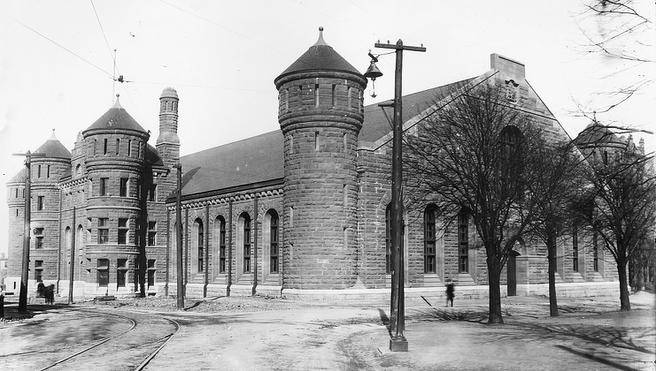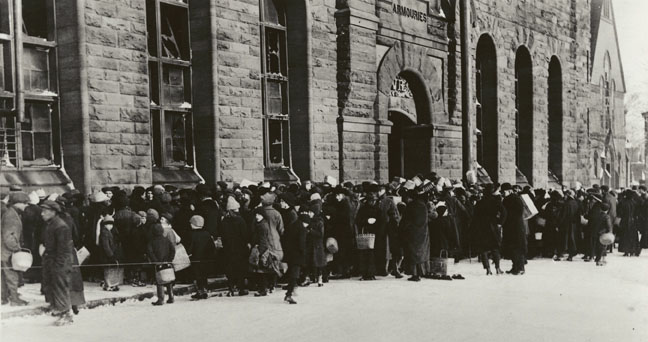Restoring 125 years of the Halifax Armouries’ military history
In November 2017, the Department of National Defence (DND) began a two-phased $160-million project to rehabilitate the Halifax Armouries.
Built in a Romanesque Revival Style between 1895 and 1899 by Thomas Fuller, Chief Architect of the Federal Department of Public Works, the armoury features towering turrets, a large unobstructed interior space and three-foot-thick red sandstone walls. It was designated a National Historic Site of Canada in 1989 and a federal classified heritage building in 1991.
This project will provide much-needed structural and interior upgrades while also maintaining the important heritage character of one of the oldest and most prominent landmarks in the city.
History of Halifax Army Reserve
Military presence in Nova Scotia can be traced to 1717 with the formation of the British infantry regiment, the 40th Regiment of Foot, in Annapolis Royal. In 1749, the city’s strategic location made Halifax a counterweight to the French presence in nearby Louisbourg, and contained a defence force comprised of a local militia and British regular troops.
In May 1860, the government of Nova Scotia formed the Halifax Volunteer Battalion of Rifles – today known as the Halifax Rifles – to solidify military forces in the area. Following Confederation in June 1869, the Canadian government authorized the formation of the Halifax Volunteer Battalion of Infantry, today called the Princess Louise Fusiliers (PLF).
In 1895, the Government of Canada invested in the construction of a modern and functional armoury which would serve as housing and provide room for training. Construction of the armoury finished in 1899.
Today, the Halifax Armouries houses the PLF, an Army Cadet Corps, and will be the future home of the Halifax Rifles (Royal Canadian Armoured Corps) Primary Reserve.
The Army Reserve units have a rich history of deployments overseas, both being deployed for the first time during the Boer War from 1899 to 1900. They also served the country during the First World War, the Second World War and have provided trained soldiers to augment missions such as in Afghanistan.
Explosion of 1917
On December 6, 1917, two ships, one of which was loaded with explosives bound for the battlefields of the First World War, collided in the port of Halifax. The shockwave produced by the detonation was the equivalent of 2,989 tons of TNT. This catastrophic event was the largest man-made explosion until the detonation of the first atomic bombs in 1945.
The city was devastated and more than 25,000 people were left without adequate shelter. A severe winter blizzard struck Halifax the following day, making the situation much worse.
The Halifax Armouries withstood the blast, losing some windows and sustaining some damage to the roof and west wall. Because damages to the armoury were minimal, it was used to shelter those who lost their homes in the explosion and as a meeting point for food distribution throughout the winter.
The armoury’s west wall was temporarily reinforced, and damages were quickly repaired after the explosion, which kept the armoury solidly in place for more than a century until rehabilitation work could begin.
The rehabilitation of Halifax Armouries: a two-phase project
DND completed foundation and drainage repairs in 2013 in preparation for the more complex and longer rehabilitation phases. Starting in 2017, the first phase of the project saw the deconstruction and rebuild of the armoury’s west wall, the addition of steel bracing in the roof that connects to the wall and meets modern seismic standards, and the widening of the entrance to accommodate modern military vehicles.
Construction projects involving heritage buildings are complex and often last many years. To protect and enhance the armoury’s heritage character, historians and architects have been working closely to develop a sound rehabilitation plan. The new red stone was excavated from agricultural land in Beckwith and at the mouth of River Phillip in Eel Creek, as these locations share the same geological veins as the original stone sourced in Wallace, Nova Scotia back in 1895. Comparable stone in strength and characteristics are also being used when Nova Scotia stone is unavailable.
The second phase of the project, divided into two parts, is now underway and is expected to be completed in 2029. Part one will rehabilitate the armoury’s remaining walls, roof, foundations and windows, and part two will upgrade the armoury’s interior to meet the current operational requirements of the two Army reserve units and cadet corps.
The project incorporates green design elements and sustainable construction practices to meet the Green Building Initiatives standards for a 3 Green Globes building certification and reduce its environmental footprint. Some green elements of the renovations include energy-efficient heating and cooling systems, high-efficiency LED lighting and controls and solar panels.
The building also uses natural design solutions for climate control, such as windows that open with controls for natural air movement and are large enough to allow for significant natural lighting. The thick masonry walls allow for natural climate control, keeping the building naturally warm in the winter and cool in summer.
The armoury is made from long-lasting stone, wood, and metals. The goal of this rehabilitation is to ensure that these materials last another 100 years, meaning less material going to landfills and less of an environmental impact from using new resources.

Caption
The North Park Armoury, built from 1895 to 1899

Caption
The armoury withstood the blast of the Halifax Explosion, and became a place of refuge for local citizens

Caption
A two-phase, $160-million renovation is underway to preserve the armoury and meet operational needs for the future